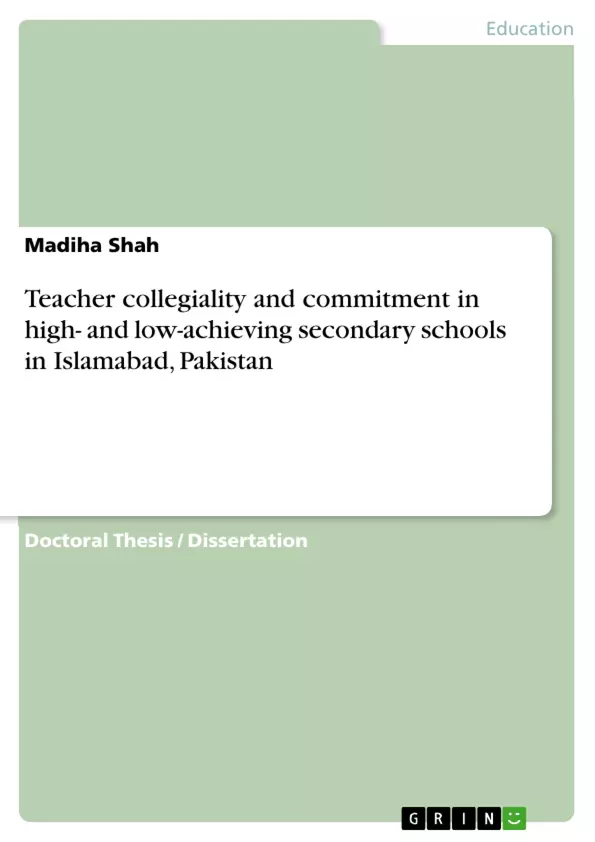This study analyzed the impact of teachers’ collegiality on their organizational and professional commitment in public secondary schools in Islamabad, Pakistan. The study also examined the differences of teacher collegiality, organizational commitment, and professional commitment in high-achieving and low-achieving schools. The effects of teacher personal variables (e.g. gender, educational level, and professional experience) on teacher collegiality, organizational commitment, and professional commitment were also investigated.
A teacher collegiality scale (TCS) was developed and tested using exploratory and confirmatory factor analytic techniques. The final TCS comprised seven dimensions, namely (1) Demonstrating Mutual Support and Trust, (2) Observing one another Teaching, (3) Joint Planning and Assessment, (4) Sharing Ideas and Expertise, (5) Teaching each other, (6) Developing Curriculum together, and (7) Sharing Resources. The instruments of organizational commitment and professional commitment were adapted from Meyer, Allen, and Smith (1993).
The survey instrument, comprising the TCS and Commitment Scale was distributed to a sample of 364 secondary school teachers in eight high-achieving and nine low-achieving schools located in Islamabad. Structural Equation Modeling (SEM) was used to assess the impact of teacher collegiality on teachers’ organizational and professional commitment. Latent Mean Structure Analysis was used to determine the differences in teacher collegiality and teacher commitment between high-achieving and low-achieving school teachers. The effects of demographic variables on study main variables were analyzed using MANOVA.
The analysis confirmed that teacher collegiality positively impacted organizational commitment and professional commitment among secondary school teachers in Pakistan. Multi-group SEM analysis did not support for the moderating effects of school type based on achievement. The differences in teacher collegiality and professional commitment were found to be statistically non-significant between high-achieving and low-achieving school teachers. However, organizational commitment among high-achieving school teachers was significantly higher than low-achieving school teachers. Teacher collegiality among female teachers was more evident than male teachers. Female teachers were also found to be more organizationally committed in Pakistani schools.
Inhaltsverzeichnis (Table of Contents)
- CHAPTER 1 INTRODUCTION TO THE STUDY
- 1.1 Introduction
- 1.2 Background of the Study
- 1.2.1 Background Context of Pakistan Educational System
- 1.3 Statement of the Problem
- 1.4 Research Questions
- 1.5 Objectives of the Study
- 1.6 Significance of the Study
- 1.7 Operational Definitions of Important Terms
- 1.7.1 Teacher Collegiality
- 1.7.2 Organizational Commitment
- 1.7.3 Organization
- 1.7.4 Professional Commitment
- 1.7.5 Profession
- 1.7.6 Public Secondary Schools in Pakistan
- 1.7.7 Teachers
- 1.7.8 High-Achieving School
- 1.7.9 Low-Achieving School
- 1.8 Organization of the Thesis
- CHAPTER 2 REVIEW OF RELATED LITERATURE
- 2.1 Introduction
- 2.2 Teacher Collegiality
- 2.2.1 Models and Forms of Teacher Collegiality
- 2.2.2 Benefits of Teacher Collegiality
- 2.2.3 Barriers to Teacher Collegiality
- 2.2.4 Criticism on Teacher Collegiality.
- 2.2.5 Teacher Collegiality and School Improvement
- 2.2.6 Teacher Collegiality and Improved Teacher Instruction
- 2.2.7 Teacher Collegiality and Teacher Professional Growth and Development
- 2.2.8 Role of Leadership in Developing Teacher Collegiality
- 2.2.9 Teacher Collegiality and Student Academic Achievement
- Impact of Teacher Collegiality on Commitment
- Differences in Collegiality and Commitment between High- and Low-Achieving Schools
- Influence of Teacher Demographics on Collegiality and Commitment
- Development and Validation of a Teacher Collegiality Scale
- Implications for Theory, Practice, and Future Research
- Chapter 1: Introduction - This chapter provides an overview of the study, introducing the research topic, background information, and rationale. It outlines the problem statement, research questions, objectives, and significance of the study. The chapter concludes with operational definitions of key terms, including teacher collegiality, organizational and professional commitment, and school types, along with a description of the thesis organization.
- Chapter 2: Review of Related Literature - This chapter provides a comprehensive review of relevant literature on teacher collegiality, its models and forms, benefits, barriers, and criticisms. It explores the relationship between collegiality and school improvement, teacher instruction, professional growth, leadership, and student achievement. The chapter also examines the theoretical frameworks relevant to the study and connects them to the research questions.
Zielsetzung und Themenschwerpunkte (Objectives and Key Themes)
This study explores the relationship between teacher collegiality and organizational and professional commitment among public secondary school teachers in Islamabad, Pakistan. The study aims to analyze the impact of collegiality on commitment levels and investigate differences in these factors between high-achieving and low-achieving schools. Additionally, it examines the influence of teacher demographics, such as gender, education level, and experience, on both collegiality and commitment.Zusammenfassung der Kapitel (Chapter Summaries)
Schlüsselwörter (Keywords)
This study focuses on teacher collegiality, organizational and professional commitment, and school achievement in public secondary schools in Pakistan. It explores the impact of collegiality on teacher commitment levels, investigates differences between high- and low-achieving schools, and examines the influence of demographic variables on both collegiality and commitment. Key terms include: teacher collegiality, organizational commitment, professional commitment, high-achieving schools, low-achieving schools, Pakistan, educational system, teacher demographics.- Quote paper
- Dr. Madiha Shah (Author), 2011, Teacher collegiality and commitment in high- and low-achieving secondary schools in Islamabad, Pakistan, Munich, GRIN Verlag, https://www.grin.com/document/192444



